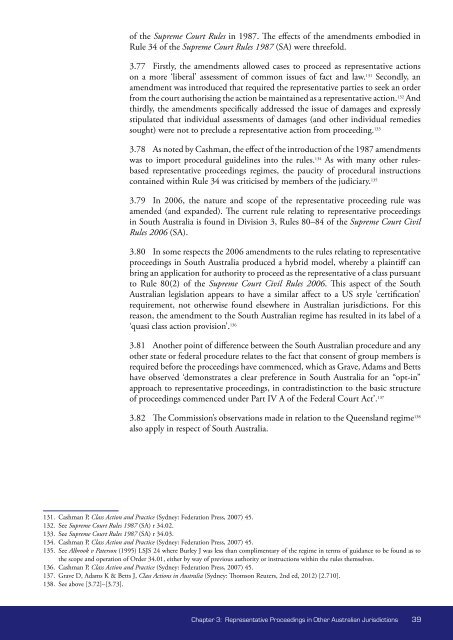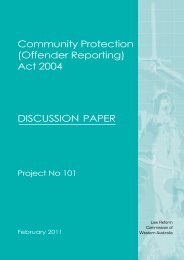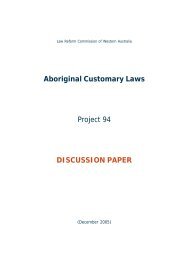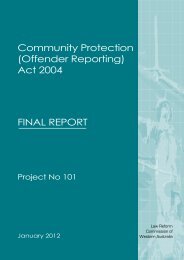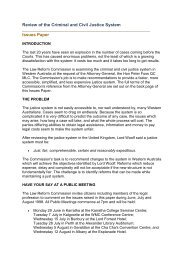Discussion Paper - Law Reform Commission of Western Australia
Discussion Paper - Law Reform Commission of Western Australia
Discussion Paper - Law Reform Commission of Western Australia
You also want an ePaper? Increase the reach of your titles
YUMPU automatically turns print PDFs into web optimized ePapers that Google loves.
<strong>of</strong> the Supreme Court Rules in 1987. The effects <strong>of</strong> the amendments embodied in<br />
Rule 34 <strong>of</strong> the Supreme Court Rules 1987 (SA) were threefold.<br />
3.77 Firstly, the amendments allowed cases to proceed as representative actions<br />
on a more ‘liberal’ assessment <strong>of</strong> common issues <strong>of</strong> fact and law. 131 Secondly, an<br />
amendment was introduced that required the representative parties to seek an order<br />
from the court authorising the action be maintained as a representative action. 132 And<br />
thirdly, the amendments specifically addressed the issue <strong>of</strong> damages and expressly<br />
stipulated that individual assessments <strong>of</strong> damages (and other individual remedies<br />
sought) were not to preclude a representative action from proceeding. 133<br />
3.78 As noted by Cashman, the effect <strong>of</strong> the introduction <strong>of</strong> the 1987 amendments<br />
was to import procedural guidelines into the rules. 134 As with many other rulesbased<br />
representative proceedings regimes, the paucity <strong>of</strong> procedural instructions<br />
contained within Rule 34 was criticised by members <strong>of</strong> the judiciary. 135<br />
3.79 In 2006, the nature and scope <strong>of</strong> the representative proceeding rule was<br />
amended (and expanded). The current rule relating to representative proceedings<br />
in South <strong>Australia</strong> is found in Division 3, Rules 80–84 <strong>of</strong> the Supreme Court Civil<br />
Rules 2006 (SA).<br />
3.80 In some respects the 2006 amendments to the rules relating to representative<br />
proceedings in South <strong>Australia</strong> produced a hybrid model, whereby a plaintiff can<br />
bring an application for authority to proceed as the representative <strong>of</strong> a class pursuant<br />
to Rule 80(2) <strong>of</strong> the Supreme Court Civil Rules 2006. This aspect <strong>of</strong> the South<br />
<strong>Australia</strong>n legislation appears to have a similar affect to a US style ‘certification’<br />
requirement, not otherwise found elsewhere in <strong>Australia</strong>n jurisdictions. For this<br />
reason, the amendment to the South <strong>Australia</strong>n regime has resulted in its label <strong>of</strong> a<br />
‘quasi class action provision’. 136<br />
3.81 Another point <strong>of</strong> difference between the South <strong>Australia</strong>n procedure and any<br />
other state or federal procedure relates to the fact that consent <strong>of</strong> group members is<br />
required before the proceedings have commenced, which as Grave, Adams and Betts<br />
have observed ‘demonstrates a clear preference in South <strong>Australia</strong> for an “opt-in”<br />
approach to representative proceedings, in contradistinction to the basic structure<br />
<strong>of</strong> proceedings commenced under Part IV A <strong>of</strong> the Federal Court Act’. 137<br />
138<br />
3.82 The <strong>Commission</strong>’s observations made in relation to the Queensland regime<br />
also apply in respect <strong>of</strong> South <strong>Australia</strong>.<br />
131. Cashman P, Class Action and Practice (Sydney: Federation Press, 2007) 45.<br />
132. See Supreme Court Rules 1987 (SA) r 34.02.<br />
133. See Supreme Court Rules 1987 (SA) r 34.03.<br />
134. Cashman P, Class Action and Practice (Sydney: Federation Press, 2007) 45.<br />
135. See Albrook v Paterson (1995) LSJS 24 where Burley J was less than complimentary <strong>of</strong> the regime in terms <strong>of</strong> guidance to be found as to<br />
the scope and operation <strong>of</strong> Order 34.01, either by way <strong>of</strong> previous authority or instructions within the rules themselves.<br />
136. Cashman P, Class Action and Practice (Sydney: Federation Press, 2007) 45.<br />
137. Grave D, Adams K & Betts J, Class Actions in <strong>Australia</strong> (Sydney: Thomson Reuters, 2nd ed, 2012) [2.710].<br />
138. See above [3.72]–[3.73].<br />
Chapter 3: Representative Proceedings in Other <strong>Australia</strong>n Jurisdictions 39


